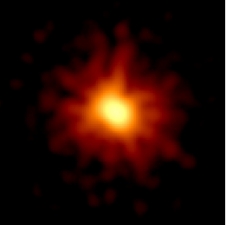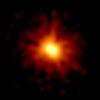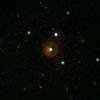Looking for optical transitions possibly related to candidates for gravitational waves
2016.02.11 13:17 - admin

GRB 080319B – an unusual gamma burst observed in the Boötes constellation by the Pi of the Sky instruments (photo NASA/Swift/Stefan Immler, et al., public domain)
Polish scientists involved in the Pi of the Sky astronomical project are looking for optical transitions related to candidates for gravitational waves detected in data acquired by the Advanced LIGO and Advanced Virgo interferometers. The search is conducted within framework of the EM Follow-up project run by the LSC-Virgo collaboration. Data acquired by Pi of the Sky telescopes are analysed jointly by Pi of the Sky and Polgraw research teams.
The Pi of the Sky robotised optical telescopes have been deployed by PAN Theoretical Physics Centre, Warsaw University, and NCBJ on both southern and northern hemisphere in two locations. A single telescope deployed in the San Pedro de Atacama (SPdA in Chile) observatory is equipped with two lenses of a 20 x 20º field of view; both lenses are looking at the same fragment of the skies. Each of the four robotised telescopes deployed in Huelva (Instituto National de Technica Aeroespecial INTA, Spain) is equipped with four cameras; field of view of each robot is about 76 x 76º. Exposition time used in both observatories is 10 s, objects brighter than about 12 magnitudo may be observed. The SPdA telescope and one of the robots deployed in INTA have been allocated to the EM Follow-up project.
The Pi of the Sky project has been run since 2004. The GRB080319B observation published in 2008 in Nature was the most interesting scientific result among all those obtained. The Pi of the Sky telescopes feature a very large field of view in comparison with other similar equipment, which makes them very fit to quickly scan the skies in search for optical bursts.
In 2014 the Pi of the Sky team signed with the LSC-Virgo collaboration a Memorandum of Understanding in the matter of participation in the EM Follow-up project. The project has been split into several Science Runs (individual sessions during which data are acquired by LSC-Virgo). Only two Advanced LIGO interferometers were used during the First Observing Run (O1) held between September 14, 2015 and January 12, 2016. The O2 next session is scheduled to commence in the second half of 2016 and to last six months; both two Advanced LIGO interferometers and the Advanced Virgo interferometer are to be used. Participation of three detectors should improve the chances to localize potential sources of gravitational waves in the skies. The O3 next session (also with the use of all three detectors) is scheduled to commence at the 2017/2018 turn and to last nine months. Subsequent sessions are planned later until detectors will attain their assumed sensitivity and will not be turned off any more.
During each LSC-Virgo data acquisition session some specialized algorithms are analysing in real time the data stream in search for candidates for gravitational waves. Information on each candidate sufficiently discriminated above the noise level (map of probability where the potential source of the waves might be located in the skies) is immediately transferred to more than 60 astronomical observatories that collaborate with LSC-Virgo. Maps sent during the O1 session could cover skies fragments of an area as large as 2,000 square degrees (for comparison let us recall that field of view of an average telescope of a 10 inch mirror is about 1 square degree). Position accuracy should be much better during the O2 session. Fields of view of the Pi of the Sky telescopes (400 square degrees for the SPdA telescope, 1,500 square degrees for the INTA telescopes) are among the largest ones of all telescopes participating in the project.
Many of the potentially detectable events in which gravitational waves are emitted (merger of two neutron stars, supernova explosion etc.) may also emit electromagnetic waves (optical bursts). Eventual observation of a combined emission of gravitational waves and optical bursts may yield some very interesting scientific results since information carried by the former (acceleration of masses within the source) are complementary to those carried by the latter (result of the generating process: supernova, gamma burst afterglow etc.). In short, gravitational waves may inform how the most energetic processes in the Universe are running, while electromagnetic waves may inform what is the outcome of the processes.
During the O1 session the Pi of the Sky telescopes observed all candidates for gravitational waves except the candidate suggested in the GW150914 alert.
Earlier in 2009-2010 the Pi of the Sky team participated in the Looc-Up similar LSC-Virgo project whose objective was to search for optical bursts related to candidates for gravitational waves suggested by the previous generation of the LIGO and Virgo interferometers. Results of the Looc-Up project have been published in two papers: A&A 539, A124 (2012) and ApJS 211 (2014) 7.


















